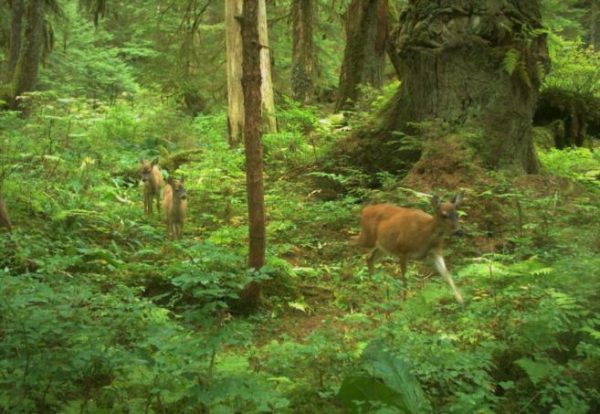
For decades it’s been challenging for scientists to survey Sitka black-tailed deer in Southeast Alaska’s forested landscape. Now, a new way of counting the deer is showing some promising results.
Thousands of black-tailed deer are harvested by hunters every year in Southeast Alaska. Scientists have relied on harvest data and some seasonal alpine surveys to manage the population. But they’ve been searching for a better prediction model for decades. Scientists are now experimenting with a three-year study on Petersburg’s Mitkof Island and if it pans out, it could have many applications elsewhere.
“The first season of sampling went really well,” said Dan Eacker, who is leading the study. He’s a research biologist with the Alaska Department of Fish and Game. He’s trying to find a better way to estimate the local deer population by using a combination of data collecting, DNA tests, game cameras, and collaring.
The DNA tests involve gathering deer fecal pellets and sending them to a lab to identify individual deer through genotyping or the sample’s genetic make-up. Results are back for the first year of the study and Eacker says they were able to identify 68 different deer. That’s much better than he expected.
“It turned out that we got 90 percent success rates on the genotyping,” Eacker said.
That’s a big deal because past attempts had success rates of just 20 to 30 percent. Eacker says sampling is difficult in the local rainforest.
“It’s so wet out here, it rains all the time, that degrades DNA,” said Eacker. “It degrades so fast that it’s hard for the lab to actually get that back, successfully amplify that DNA, and be able to tell one individual from another.”
Telling deer apart helps scientists get a better population count.
So, why has Eacker’s sampling been more successful? He’s focused efforts in the winter when pellets are better preserved in cold. Plus, he’s tracking deer in the snow to get the freshest samples.
Every sample costs $60 to process so getting more results from fewer samples is important.
“It saved a lot of money but it also means that this technique will be viable to get better information about deer population; deer density,” Eacker said.
Getting a good deer count could help managers in Southeast set appropriate harvest limits. In some areas, managers believe there is an abundant deer population, like Admiralty, Baranof and Chichagof Islands, which have harvest limits up to six deer per resident hunter in most areas.
That’s not the case near Petersburg where the harvest is limited to one buck.
Eacker says scientists have used theoretical data on the number of deer that certain landscapes can support. There are still many unknowns, like how logging affects the species.
“It’s one of the main questions that’s been unanswered since all the logging started,” Eacker said. “Even folks like, Matt Kirchhoff, some of the early deer biologists out here were trying to get at this same thing, they just didn’t have the technology at the time that we do now.”
New technology Eacker is using includes wildlife game cameras mounted in remote areas of Mitkof Island. He is able to identify individual deer through their markings. These 64 cameras capture high definition images and have battery lives of a year or longer.
Eacker also plans to use 20 high-tech GPS collars this winter, which will show biologists important information like the deer’s range and habitat selection.
“This habitat selection can be used to provide better spatial predictions of deer density,” Eacker said.
Eacker hopes that the next two years of the Mitkof Island study will continue to bring in solid data. By combining all three types of data collecting—the collars, the cameras, and the DNA– wildlife managers will be able to calculate more accurately how many deer are in a given area.
And in the future, Eacker says, the method wouldn’t have to be limited to deer. It should also work well for moose.




